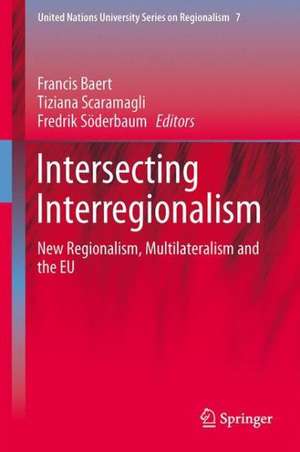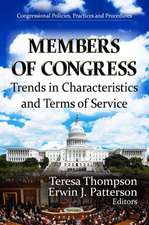Intersecting Interregionalism: Regions, Global Governance and the EU: United Nations University Series on Regionalism, cartea 7
Editat de Francis Baert, Tiziana Scaramagli, Fredrik Söderbaumen Limba Engleză Hardback – 13 ian 2014
| Toate formatele și edițiile | Preț | Express |
|---|---|---|
| Paperback (1) | 636.30 lei 6-8 săpt. | |
| SPRINGER NETHERLANDS – 17 sep 2016 | 636.30 lei 6-8 săpt. | |
| Hardback (1) | 642.51 lei 6-8 săpt. | |
| SPRINGER NETHERLANDS – 13 ian 2014 | 642.51 lei 6-8 săpt. |
Din seria United Nations University Series on Regionalism
- 15%
 Preț: 647.27 lei
Preț: 647.27 lei - 24%
 Preț: 790.70 lei
Preț: 790.70 lei - 18%
 Preț: 738.20 lei
Preț: 738.20 lei - 15%
 Preț: 645.47 lei
Preț: 645.47 lei -
 Preț: 393.35 lei
Preț: 393.35 lei -
 Preț: 395.09 lei
Preț: 395.09 lei - 15%
 Preț: 647.08 lei
Preț: 647.08 lei - 15%
 Preț: 651.67 lei
Preț: 651.67 lei - 18%
 Preț: 893.05 lei
Preț: 893.05 lei - 15%
 Preț: 641.20 lei
Preț: 641.20 lei -
 Preț: 442.46 lei
Preț: 442.46 lei - 18%
 Preț: 721.81 lei
Preț: 721.81 lei -
 Preț: 425.42 lei
Preț: 425.42 lei - 15%
 Preț: 646.11 lei
Preț: 646.11 lei - 18%
 Preț: 783.68 lei
Preț: 783.68 lei - 15%
 Preț: 690.94 lei
Preț: 690.94 lei - 15%
 Preț: 691.91 lei
Preț: 691.91 lei - 18%
 Preț: 727.80 lei
Preț: 727.80 lei - 18%
 Preț: 797.24 lei
Preț: 797.24 lei - 20%
 Preț: 560.30 lei
Preț: 560.30 lei -
 Preț: 433.68 lei
Preț: 433.68 lei - 15%
 Preț: 636.12 lei
Preț: 636.12 lei - 18%
 Preț: 940.09 lei
Preț: 940.09 lei - 20%
 Preț: 577.17 lei
Preț: 577.17 lei -
 Preț: 394.12 lei
Preț: 394.12 lei -
 Preț: 391.61 lei
Preț: 391.61 lei
Preț: 642.51 lei
Preț vechi: 755.88 lei
-15% Nou
Puncte Express: 964
Preț estimativ în valută:
122.94€ • 128.36$ • 101.75£
122.94€ • 128.36$ • 101.75£
Carte tipărită la comandă
Livrare economică 04-18 aprilie
Preluare comenzi: 021 569.72.76
Specificații
ISBN-13: 9789400775657
ISBN-10: 9400775652
Pagini: 212
Ilustrații: XIII, 196 p. 3 illus.
Dimensiuni: 155 x 235 x 22 mm
Greutate: 0.48 kg
Ediția:2014
Editura: SPRINGER NETHERLANDS
Colecția Springer
Seria United Nations University Series on Regionalism
Locul publicării:Dordrecht, Netherlands
ISBN-10: 9400775652
Pagini: 212
Ilustrații: XIII, 196 p. 3 illus.
Dimensiuni: 155 x 235 x 22 mm
Greutate: 0.48 kg
Ediția:2014
Editura: SPRINGER NETHERLANDS
Colecția Springer
Seria United Nations University Series on Regionalism
Locul publicării:Dordrecht, Netherlands
Public țintă
ResearchCuprins
Chapter 1. Introduction; Fancis Baert, Tiziana Scaramagli and Fredrik Söderbaum.- Part I. Theorising Interregionalism.- Chapter 2. Interregionalism and International Relations: Reanimating an Obsolescent Research Agenda; Jürgen Rüland.- Chapter 3. Interregionalism and the European Union: Conceptualising Group-to-Group Relations; Mathew Doidge.- Chapter 4. Regional Actorship: A Comparative Approach to Interregionalism; Björn Hettne.- Chapter 5. Interregionalism: A Security Studies Perspective; Ruth Hanau Santini, Sonia Lucarelli and Marco Pinfari.- Part II. Regional Actors and Strategies.- Chapter 6. The European Union and the Contradictions of Complex Interregionalism; Alan Hardacre and Michael Smith.- Chapter 7. The Impact of the Iberian States in the European Union-Latin American Interregionalism; Sebastian Santander.- Chapter 8. How Does the European Parliament Contribute to the Construction of EU's Interregional Dialogue; Olivier Costa and Clarissa Dri.- Chapter 9. The Court ofJustice of the European Union and Other Regional Courts; Stefaan Smis.- Chapter 10. Conclusion: Understanding Interregionalism in the 21st Century; Francis Baert, Tiziana Scaramagli and Fredrik Söderbaum.- Index.
.
.
Notă biografică
Francis Baert is Researcher at the United Nations University Institute on Comparative Regional Integration Studies (UNU–CRIS) in Bruges, and the Centre for European Studies (CEUS) of Ghent University.
Tiziana Scaramagli is Liaison Officer of the United Nations University at UNESCO and PhD Candidate at the King’s College London.
Fredrik Söderbaum (Editor) is Associate Professor in Peace and Development Research in the School of Global Studies and the Centre of Globalization and Development, the University of Gothenburg. He is also Associate Senior Research Fellow at the United Nations University Institute on Comparative Regional Integration Studies (UNU–CRIS) in Bruges.
Tiziana Scaramagli is Liaison Officer of the United Nations University at UNESCO and PhD Candidate at the King’s College London.
Fredrik Söderbaum (Editor) is Associate Professor in Peace and Development Research in the School of Global Studies and the Centre of Globalization and Development, the University of Gothenburg. He is also Associate Senior Research Fellow at the United Nations University Institute on Comparative Regional Integration Studies (UNU–CRIS) in Bruges.
Textul de pe ultima copertă
Intersecting Interregionalism moves beyond narrow understandings of regions and interregionalism that dominate the research field by focusing on the polymorphous nature of the concepts under study, theoretical advances and the empirical challenges ahead. Written by leading experts in the field, the ultimate aim of the book is to contribute to a more relevant and nuanced comparative research agenda on interregionalism in Europe and elsewhere.
The volume is divided into two parts. The first provides an overview of several distinctive theoretical perspectives, with particular emphasis on the dynamic relationship between regions and interregionalism. The second part of the book uncovers the diversity of regional actors and institutions that are engaged in the creation of contemporary interregionalism. The EU is used as an entry point and detailed case studies explore the role of EU member states, the Council, the Commission, the European Parliament and the Court of Justice, in order to map out a patchwork of intersecting interregionalisms around the world.
The volume is divided into two parts. The first provides an overview of several distinctive theoretical perspectives, with particular emphasis on the dynamic relationship between regions and interregionalism. The second part of the book uncovers the diversity of regional actors and institutions that are engaged in the creation of contemporary interregionalism. The EU is used as an entry point and detailed case studies explore the role of EU member states, the Council, the Commission, the European Parliament and the Court of Justice, in order to map out a patchwork of intersecting interregionalisms around the world.
Caracteristici
Leads the way into the next generation of research on interregionalism Contributes to a more productive debate between diffferent theoretical standpoints Constitutes the first systematic attempt to bring together leading theories and theorists of interregionalism Unpacks and problematises the region, the driving actors and institutions that are engaged in interregional relations ?











